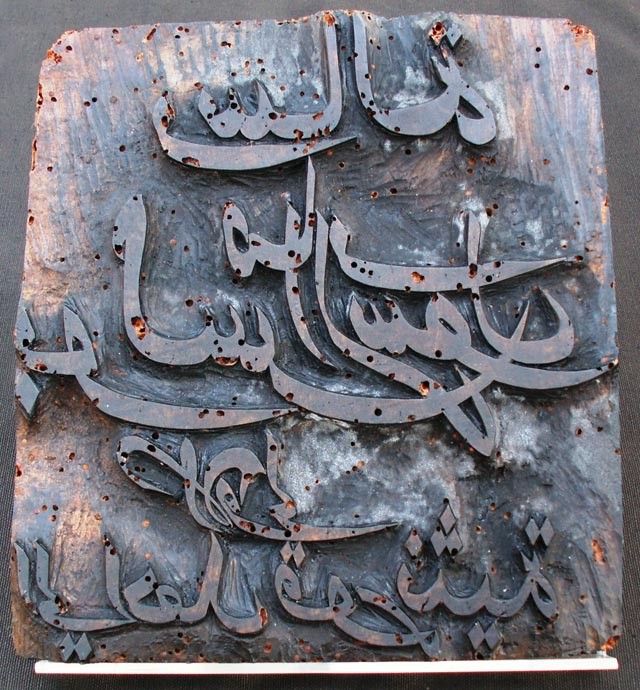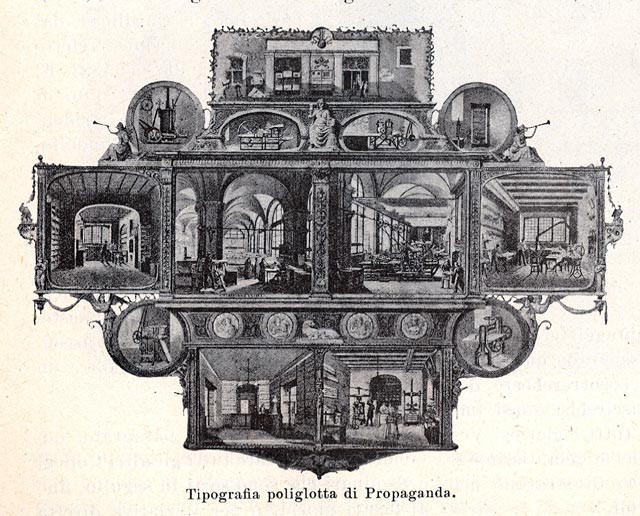POLYGLOT TYPOGRAPHY
Details of the establishment of the Polyglot Typography are visible in the acts of the general Congregation held on 3 June 1626. In the same year, Emperor Ferdinand II gave to Propaganda Fide "the Illyrian characters of St. Jerome and St. Cyril," that is Western and Cyrillic Glagolitic, respectively. With these characters, from Austria to Rome via Ancona, and with the addition of other Greek and Latin characters found in Rome, Giovanni Bandini and Francesco Paolini, correctors of the Printing House, started the work of the Printing of Propaganda. Work held in high regard right from the beginning, the new typography depended on the Prefecture of the Press, whose first prefect was Cardinal Guido Bentivoglio. Later, a prefecture responsible for the correction of the books of the Eastern Churches was added.
The creation of a typography at the service of the propagation of the Faith was considered so necessary that it followed shortly after the establishment of the Congregation De Propaganda Fide, even before that of the Urban College, first building of the University, founded by Pope Urban VIII in 1627.
The first volume printed was probably a Greek version of Guía de pecadores of the Dominican friar Luigi da Granada, written in 1588, followed by works of grammar, law, controversy and spirituality, all at the service of the missionaries of the East.
The first catalogue, published in 1639, contained the titles already published since1628, while the second catalogue of the Printing of Propaganda, which appeared in 1667, is a splendid example of missionary strength and technical expertise.
Planned by the Greek Leo Allatius, the catalogue presented some excellent works at the service of missionaries, like those of the Maronite Abraham Ecchellensis (1600-1664), of the same Allatius, of Cardinal Bona, of the Discalced Carmelites missionaries, completed in various Western and Eastern languages.
Among the many important works published by the Printing House, the first complete edition of the entire Bible in Arabic must be mentioned, published in 1671, and preserves the wood matrix used to print the opening words of the First Letter to the Corinthians.
When the fifth catalogue was printed in 1761, edited by Costantino Ruggeri, the printing technique had reached very high levels. The Printing of Propaganda seemed well established. The supervisor of the printing works at the time was the great Augustine Rufus from Verona, while the young Giambattista Bodoni (Saluzzo 1740 - Parma 1813) worked for the first years of service as an apprentice.
When he arrived in Rome in 1758, Bodoni carried out his typographic art in the Printing of Propaganda until 1767, the year in which he moved to the Ducal Court of Parma, where he soon became "the king of typography" throughout Europe, without cutting ties with Propaganda Printing.
Despite the looting suffered during the French Revolution, the Printing soon recovered and its missionary work was invaluable throughout the nineteenth century.
In 1909 his Acta Sanctae Sedis paved the way to Acta Apostolicae Sedis and in that same year, at the service of the Holy See, the Printing of De Propaganda Fide was incorporated in the Vatican Polyglot Typography.


 Matrice xilografica Bibbia in arabo (1671)
Matrice xilografica Bibbia in arabo (1671)
 Incisione Tipografia Poliglotta
Incisione Tipografia Poliglotta
 Scatola in legno con caratteri cinesi in piombo
Scatola in legno con caratteri cinesi in piombo